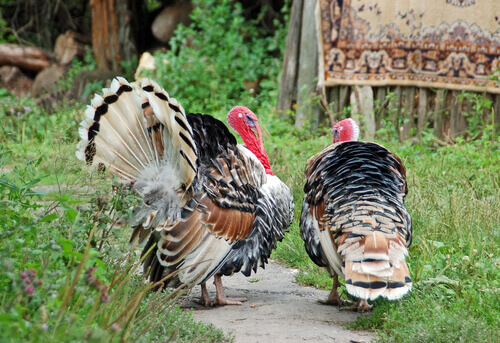Tips for Raising Domestic Turkeys


Written and verified by the lawyer Francisco María García
Many people raise turkeys for personal consumption or to sell them for food. In some countries, in particular, turkey is a typical Christmas and Thanksgiving meal. Therefore, raising domestic turkeys provides a lot of profits during this time.
Nevertheless, the nutritional properties that turkey meat has in comparison to other animals have caused it to become a more common element in our daily diet.
Besides having a more complete meat than that of other animals, turkey breast is low in sodium. What’s more, it has fewer calories and fat and contains more protein, calcium, and vitamins than chicken breast. Also, compared to other red meats, turkey is one of the lowest in cholesterol.
The quality of the product that we extract from turkeys will vary according to the food that they’ve consumed during its breeding. The right diet while raising domestic turkeys is what will guarantee healthy nutrition for human consumption and, at the same time, a successful business.
Breeding the domestic turkey
Although they’re birds, turkeys are not able to fly because their wings are twice as big. They can measure up to one 1 foot, 4 inches and their weight can vary from 9 to 44 pounds.

During the first months of life, turkey chicks spend their days under their mother’s wings. In a natural environment, turkey offspring can eat on their own from birth.
Their daily menu includes insects, grains, leaves and stones, fruits, acorns, and other wild species. They also feed on worms, snails, insect larvae, seeds, wheat bran, vegetables, and cereals.
How to achieve the breeding of numerous turkeys
When it comes to hatcheries with a large number of turkeys, they generally use other forms of breeding different from those we’ll mention.
Some of the best known breeding techniques in large hatcheries include keeping the turkey in an incubator. Breeders cover the bottom with paper and place food there from the time chicks are born.
Inside this room, there should be 120 or 250 watt lamps located above the animals. This guarantees that the temperature of the environment is around 93ºF during the animal’s first weeks of life.
What do turkeys eat?
After this time, turkeys can begin eating turkey feed. Both the feed and water containers should contain enough food to guarantee their placement every 25 birds. It’s important to keep food and water away from the heat of the lamps, but also to ensure that the food is within the turkeys’ reach.
During the first few weeks of raising domestic turkeys, their diet should contain 30% protein in each ration, adding corn and oats at about 14 weeks. At 80 days, turkeys can begin incorporating potatoes and cereals into their diet. And, at the same time, they should be free to consume grass.
Raising these birds with commercial food isn’t recommended, since this reduces the quality of its meat. It’s also important to prevent excessive growth, as abnormal size alludes to improper feeding (with artificial food). Consumers know that the more natural the turkey’s food is, the better its meat will be.
Turkey preservation
Females are able to reproduce from the age of three and can do so only in spring. During this time, they’ll lay between eight and fifteen eggs, which they’ll incubate for 28 days.
In order to preserve the turkey’s well-being and guarantee quality meat, it’s important to take certain precautions. Tor example, isolating sick birds to reduce the risk of contagion and disease transmission.
It’s also important to apply preventive measures that aim to reduce the level of cannibalism. On the one hand, turkeys should be given enough space so that they can move away from others, go out to graze, as well as stay away from light and heat.
Once a turkey has grown enough, but is still young, it’s a good idea to cut off the tip of its beak. This prevents the possibility of pecking, which could result in the death of one of the males in the group.
All cited sources were thoroughly reviewed by our team to ensure their quality, reliability, currency, and validity. The bibliography of this article was considered reliable and of academic or scientific accuracy.
- Radzimirska, M. (2003). The morphology, topography and cytoarchitectonics of the ciliary ganglion in the domestic turkey (Meleagris gallopavo domesticus). Folia morphologica, 62(4), 389-391.
- Skieresz-Szewczyk, K., Plewa, B., & Jackowiak, H. (2021). Functional morphology of the tongue in the domestic turkey (Meleagris gallopavo gallopavo var. domesticus). Poultry Science, 100(5), 101038.
- Christensen, V. L. (1980). Physiological parameters limiting hatchability in the domestic fowl (Gallus domesticus) and domestic turkey (Meleagris gallopavo). Dissertation Abstracts International, B, 40(9), 4041-4042.
This text is provided for informational purposes only and does not replace consultation with a professional. If in doubt, consult your specialist.